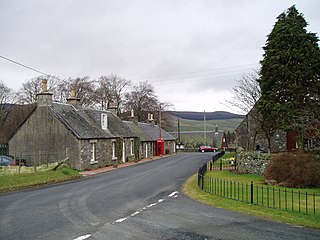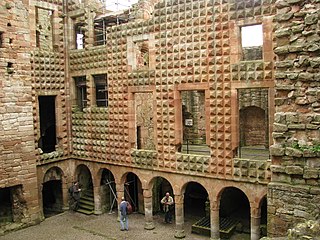Patrick Hepburn, 1st Earl of Bothwell was Lord High Admiral of Scotland. He rose to political prominence after supporting James IV against his father, and was proxy at the King's marriage.

George Home, 1st Earl of Dunbar, KG, PC was, in the last decade of his life, the most prominent and most influential Scotsman in England. His work lay in the King's Household and in the control of the State Affairs of Scotland and he was the King's chief Scottish advisor. With the full backing and trust of King James he travelled regularly from London to Edinburgh via Berwick-upon-Tweed.

Drumelzier, is a village and civil parish on the B712 in the Tweed Valley in the Scottish Borders.

Tantallon Castle is a ruined mid-14th-century fortress, located 5 kilometres (3.1 mi) east of North Berwick, in East Lothian, Scotland. It sits atop a promontory opposite the Bass Rock, looking out onto the Firth of Forth. The last medieval curtain wall castle to be constructed in Scotland, Tantallon comprises a single wall blocking off the headland, with the other three sides naturally protected by sea cliffs.

Crichton Castle is a ruined castle near the village of Crichton in Midlothian, Scotland. It is situated at the head of the River Tyne, 2 miles (3.2 km) south of the village of Pathhead, and the same distance east of Gorebridge.

Hailes Castle is a mainly 14th century castle about a mile and a half south-west of East Linton, East Lothian, Scotland. This castle, which has a fine riverside setting, belonged to the Hepburn family during the most important centuries of its existence. Since 1926, it has been the subject of a state-sponsored guardianship agreement, which is now under the auspices of Historic Environment Scotland as a scheduled monument.

Newark Tower is a large, ruined tower house standing in the grounds of Bowhill House, in the valley of the Yarrow Water three miles west of Selkirk in the Scottish Borders. In addition to the keep, sections of a gatehouse and wall survive. It has been designated a scheduled monument by Historic Environment Scotland.

Morham, East Lothian, sometimes spelt Moram, Morum, or Morhame in old records, is the smallest (agricultural) parish in Scotland, sandwiched between five other parishes: Haddington, Garvald, Yester, Whittingehame, and Prestonkirk, in the undulating lower reaches of the Lammermuir Hills.
Robert Lauder of The Bass was an important noble in Haddingtonshire, the Merse, and Fife. Stodart remarks that "to 1600 the barons of the Bass sat in almost every parliament". He was a firm supporter of Mary, Queen of Scots whom he accompanied to Carberry Hill on 14 June 1567, and fought for at the battle of Langside.

Dryhope Tower is a ruined Scottish peel tower in the valley of the Yarrow Water, in the historic county of Selkirkshire, now part of the Scottish Borders. It lies approximately equidistant between the burghs of Moffat and Selkirk, and defended the north eastern end of St Mary's Loch. The site itself was protected on two sides, to the east by the Dryhope Burn and to the west by the Kirkstead Burn.

Francis Stewart, 5th Earl of Bothwell, was Commendator of Kelso Abbey and Coldingham Priory, a Privy Counsellor and Lord High Admiral of Scotland. He was a notorious conspirator who led several uprisings against his first cousin, King James VI, all of which ultimately failed, and he died in poverty in Italy after being banished from Scotland. Francis's maternal uncle, the 4th Earl of Bothwell, was the chief suspect in the murder of James VI's father, Lord Darnley.
Sir William Stewart of Houston was a Scottish soldier, politician and diplomat.
Alexander Home, 3rd Lord Home was a Scottish soldier and nobleman, Chamberlain of Scotland and Warden of the Eastern March. He fought at the Battle of Flodden where his forces defeated the English right wing before the Scottish army was destroyed. After the battle, he resisted the regency of John Stewart, Duke of Albany and was captured and executed for rebellion.

Walter Scott of Harden, also known as Auld Wat, was a notorious border reiver along the Anglo-Scottish border in the 16th century.
Lady Agnes Stewart (1480-1557) was a Scottish noble, a cousin of King James IV of Scotland. She was born the illegitimate daughter of James Stewart, 1st Earl of Buchan and Margaret Murray. On 31 October 1552 she was legitimized under the Great Seal of Scotland.

Alexander Lindsay, 1st Lord Spynie was a Scottish nobleman. His death is the subject of the ballad Lord Spynie.
William Stewart of Monkton and Carstairs was a Scottish landowner and courtier.
Margaret Douglas, Countess of Bothwell was a Scottish aristocrat and courtier.

James Douglas of Spott was a Scottish landowner and conspirator.
William Stewart of Caverston and Traquair, was a Scottish landowner and Captain of Dumbarton Castle.












